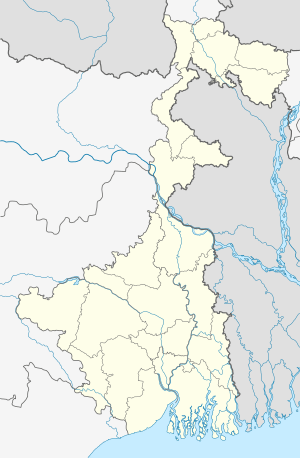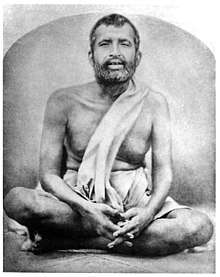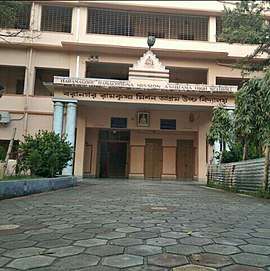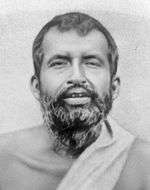Dakshineswar Kali Temple
Dakshineswar Kali Temple is a Hindu navaratna temple located at Dakshineswar. Situated on the eastern bank of the Hooghly River, the presiding deity of the temple is Bhavatarini, an aspect of Kali, meaning, 'She who liberates Her devotees from the ocean of existence i.e. Saṃsāra'.[1] The temple was built in 1855 by Rani Rashmoni, a philanthropist and a devotee of Kali. The temple is famous for its association with Ramakrishna, a mystic of 19th Century Bengal.[2][3]
| Dakshineswar Kali Temple | |
|---|---|
দক্ষিণেশ্বর কালীবাড়ি | |
Dakhineshwar Temple beside the River Hooghly, West Bengal | |
| Religion | |
| Affiliation | Hinduism |
| District | North 24 Parganas |
| Deity | Bhavatarini Kali |
| Festivals | Kali Puja, Snana Yatra, Kalpataru Day |
| Location | |
| Location | Greater Kolkata |
| State | West Bengal |
| Country | India |
 Location in West Bengal | |
| Geographic coordinates | 22°39′18″N 88°21′28″E |
| Architecture | |
| Type | Bengal architecture |
| Style | Navaratna |
| Creator | Rani Rashmoni |
| Completed | 1855 |
| Temple(s) | 12 Shiva temples, 1 temple of Radhakrishna and 1 Main Temple of Goddess Kali |
| Website | |
| Official website | |
The temple compound, apart from the nine-spired main temple, contains a large courtyard surrounding the temple, with rooms along the boundary walls. There are twelve shrines dedicated to Shiva—Kali's companion—along the riverfront, a temple to Radha-Krishna, a bathing ghat on the river, a shrine dedicated to Rani Rashmoni. 'Nahabat', the chamber in the northwestern corner just beyond the last of the Shiva temples, is where Ramakrishna and Maa Sarada spent a considerable part of their lives.[2][4]
History
The Dakshineswar Kali Temple was founded around the middle of the 19th century by Rani Rashmoni.[5] Rani Rashmoni was a Mahishya by caste[6] and was well known for her philanthropic activities. In the year 1847, Rashmoni prepared to go upon a long pilgrimage to the sacred Hindu city of Kashi to express her devotions to the Divine Mother. Rani was to travel in twenty-four boats, carrying relatives, servants, and supplies.[4] According to traditional accounts, the night before the pilgrimage began, Rashmoni had a vision of the Divine Mother in the form of the goddess Kali in a dream and reportedly said,[7]
There is no need to go to Banaras. Install my statue in a beautiful temple on the banks of the Ganges river and arrange for my worship there. Then I shall manifest myself in the image and accept worship at that place.
Profoundly affected by the dream, Rani immediately looked for and purchased a 30,000-acre plot in the village of Dakhineswar. The large temple complex was built between 1847 and 1855. The 20-acre (81,000 m2) plot was bought from an Englishman, Jake Hastie, and was then popularly known as Saheban Bagicha.[8] Partly old Muslim burial ground shaped like a tortoise, considered befitting for the worship of Shakti according to Tantra traditions, it took eight years and nine hundred thousand rupees to complete the construction. The idol of Goddess Kali was installed on the Snana Yatra day on 31 May 1855 amid festivities at the temple formally known as Sri Sri Jagadishwari Mahakali, with Ramkumar Chhattopadhyay as the head priest. Soon his younger brother Gadai or Gadadhar (later known as Ramakrishna) moved in and so did his nephew Hriday to assist him.[1][2][3][4][9] On 31 May 1855 more than 1 lakh (one hundred thousand) Brahmins were invited from different parts of the country to grace the auspicious occasion. The next year, Ramkumar Chattopadhyay died, and the position was given to Ramakrishna along with his wife Sarada Devi, who stayed in the south side of the Nahabat (music room) in a small room on the ground floor, which is now a shrine dedicated to her.
Ramakrishna was responsible for bringing much in the way of both fame and pilgrims to the temple.[10]
Rani Rashmoni lived for only five years and nine months after the inauguration of the temple. She fell seriously ill in 1861. Realizing that her death was near, she decided to hand over the property she had purchased in Dinajpur (now in Bangladesh) as a legacy for the maintenance of the temple to the temple trust. She accomplished her task on 18 February 1861 and died on the next day.[2] After her death, her sons-in-law took to celebrating Durga Puja in their respective premises.
Architecture
Built in the navaratna or nine spires style of Bengal architecture, the three-storeyed south-facing temple has nine spires distributed in upper two storeys, and stands on a high platform with a flight of stairs, overall it measures 46 feet (14 m) square and rises over 100 feet (30 m) high.[3][4]
The garbha griha (sanctum sanctorum) houses an idol of goddess Kali, known as Bhavatarini, standing on the chest of a supine Shiva, and the two idols are placed on a thousand-petaled lotus throne made of silver.[3][4]
Close to the main temple are the row of twelve identical Shiva temples built facing the east in the typical aat-chala Bengal architecture, they are built on either side of the ghat on the Hooghly river. To the North east of the Temple Complex is the Vishnu Temple or the Radha Kanta Temple. A flight of steps lead to the columned verandah and into the temple where a silver throne rests with a 21 1⁄2-inch (550 mm) idol of Lord Krishna and a 16-inch (410 mm) idol of Radha.[3][4]
Gallery
- The name of the idol of Kali worshiped in the temple is Bhavatarini. Shown here, is a picture of the deity adorned with priceless jewelleries and other accessories.
 Ramakrishna came to the temple in 1855, as an assistant to his elder brother, Ramkumar, the head priest, a job he took over the next year, after Ramkumar's death.
Ramakrishna came to the temple in 1855, as an assistant to his elder brother, Ramkumar, the head priest, a job he took over the next year, after Ramkumar's death._-_1865.jpg) Photograph of Dakshineshwar temple from Views of Calcutta and Barrackpore, taken by Samuel Bourne
Photograph of Dakshineshwar temple from Views of Calcutta and Barrackpore, taken by Samuel Bourne Dakshineshwar Kali Temple, built on a raised platform.
Dakshineshwar Kali Temple, built on a raised platform. Closeup of the spires
Closeup of the spires Columned Verandah of the temple
Columned Verandah of the temple Temple on the banks of Ganges
Temple on the banks of Ganges
See also
- Belur Math
- Kalighat Kali Temple
- Dakshina Kali
Notes
- Mehrotra 2008 p.11.
- "History of the temple". Dakshineswar Kali Temple. Retrieved 21 April 2018.
- "Dakshineswar - A Heritage". Government of West Bengal. Archived from the original on 2 September 2013. Retrieved 26 November 2012.
- Swati Mitra, ed. (2011). Kolkata: City Guide. Goodearth Publications. ISBN 978-93-80262-15-4.
- Harding 1998, p.xii
- Sen, Amiya P. (June 2006). "Sri Ramakrishna, the Kathamrita and the Calcutta middle classes: an old problematic revisited". Postcolonial Studies. 9 (2): 165–177. doi:10.1080/13688790600657835.
- Rosen, Steven (2006). Essential Hinduism. Greenwood Publishing Group. pp. 201–202. ISBN 978-0-275-99006-0.
- Prabhananda 2003
- Swami Chetanananda (2001). God lived with them. Advaita Ashrama. p. 655. ISBN 978-0-916356-79-8.
- Balakrishnan, S (9 May 2003). "Kali Mandir of Kolkata". The Hindu. Retrieved 21 April 2018.
References
- Dutta, Krishna (2003). Calcutta: a cultural and literary history. Signal Books. p. 255. ISBN 978-1-902669-59-5.
- Prabhananda, Swami (October 2003). "The Kali Temple at Dakshineswar and Sri Ramakrishna". Vedanta Kesari.
- "Map of Kali Temple at Dakshineshwar". Archived from the original on 12 June 2008. Retrieved 5 November 2008.
- Harding, Elizabeth U. (1998). Kali: The Black Goddess of Dakshineswar. Motilal Banarsidass. ISBN 81-208-1450-9.
- Mehrotra, Rajiv (2008). Thakur: A Life Of Sri Ramakrishna. Penguin Books India. ISBN 0-14-306371-5.
External links
| Wikimedia Commons has media related to Dakshineswar Kali Temple. |
- Official website




